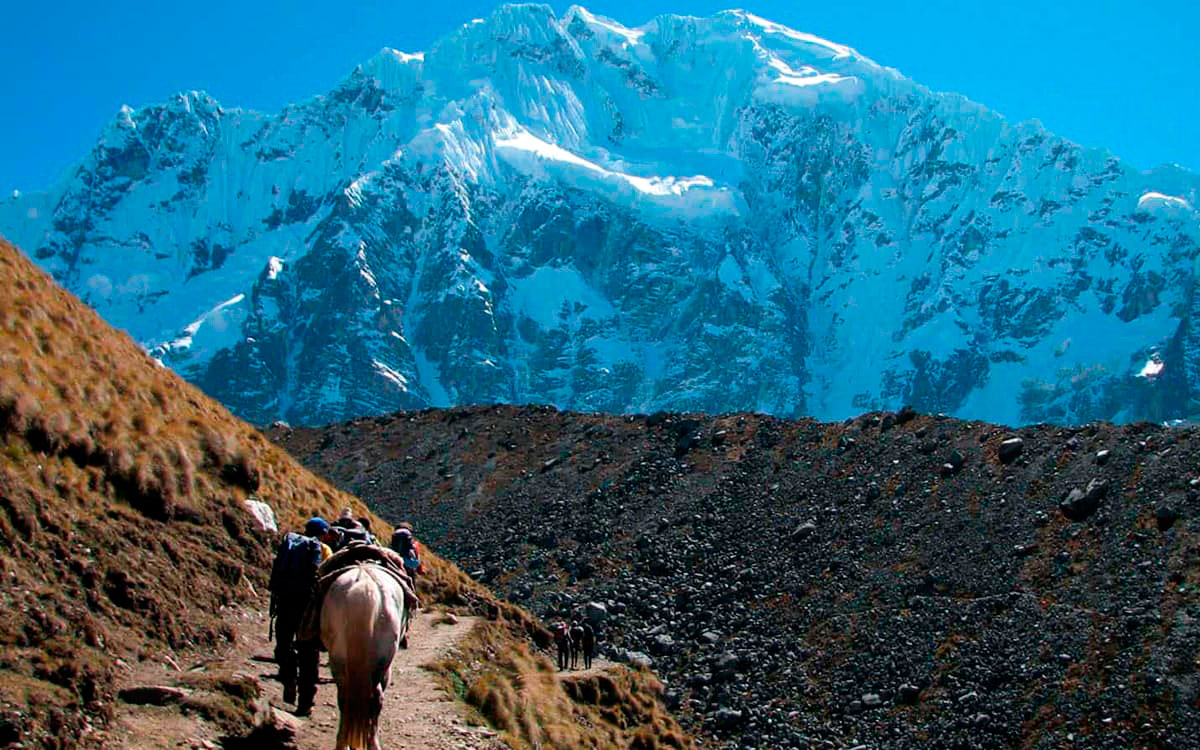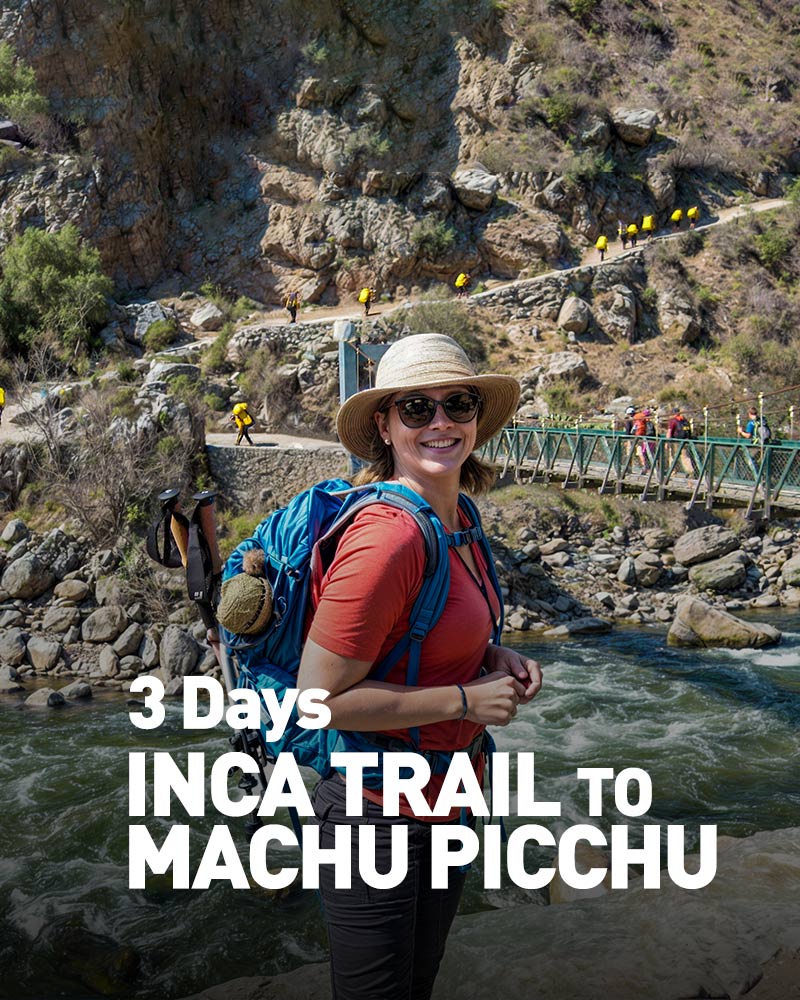The Classic Inca Trail is one of the trails, the most popular, that connects Cusco with Machu Picchu. If you plan to stay in Cusco for several days, don't miss the opportunity to walk this 43-kilometer trail on foot.
The second option to reach Machu Picchu on foot is through the 2 day Inca Trail, starting at the Km 104 to Machu Picchu. This route is also known as the short Inca Trail. Like the previous route, it can be traveled only with a travel agency.
The trip begins in Cusco, from where your travel agency will take you by bus to kilometer 104, the starting point of the trek. And from Km 104, in just a single day of walking, you will reach the citadel of Machu Picchu.
Elevation of Km 104 in the Inca Trail
The elevation of Km 104 in the Inca Trail is 2,200 masl / 7,218 ft. The Elevation of Km 104 in the Inca Trail is where we start the Short Inca Trail Trek.
Distance from Km 104 to Machu Picchu
The distance from Km 104 to Machu Picchu is 12 kilometer. You must walk the distance from Km 104 to Machu Picchu with a profesional tour guide.

How to get to Km 104 of the Inca Trail?
Very early 04:00 a.m. we go to the Ollantaytambo train station, to go to Km 104 of the Inca Trail, where we will start the trekking, we will go through a control. Remember that the train will not stop unless you request it and it will not stop for a long time, so you must be aware of the kilometer marking.
The train takes us to the starting point of the walk, called Km 104 of the Inca Trail on the railway. Right at the beginning of the trail, you will see many endemic exotic birds such as the Andean guan and the Gray-breasted Mountain Toucan, as well as various wild orchids and bromeliads along the way.
Inca Trail to Machu Picchu
The 4 day Inca Trail Tour is one of the trails, the most popular, that connects Cusco with Machu Picchu. If you plan to stay in Cusco for several days, don't miss the opportunity to walk this 43-kilometer trail on foot. The trip lasts four days and you will discover incredible forests, ancient villages and stone stairs that seem to rise to heaven. At the end of this trip, the Puerta del Sol and the sacred city of the Incas await you.

Versions of the Inca Trail to Machu Picchu
Not all people have the days necessary to travel the Inca Trail (4 days and 3 nights). That is why there are 2 versions depending on the time you have:
- Classic Inca Trail: 4 days and 3 nights (43 kilometers of walking).
- Short Inca Trail: 2 days and 1 night (12 kilometer walk).
Also, you can get to Machu Picchu from Cusco, choosing the following routes of the Inca trail: Machu Picchu 3 day hike and 2 day Inca Trail with camping.
Short Inca Trail to Machu Picchu (Km 104)
If you do not have enough time, to do the 4-day Inca Trail, the trail from Km 104 to Machu Picchu is a good option; it is a section of the Inca Trail that begins at Km 104 of the Cusco - Aguas Calientes railway line.
This is an uphill hike, make sure you have everything you need such as: repellent sunscreen, head protection, water, etc. In the route from Km 104 to Machu Picchu you will have to constantly climb grasslands for 3 hours until you reach Wiñayhuayna and another two hours of walking until you reach the entrance to Machu Picchu. Previously, it will have passed through archaeological sites with a wide variety of sources or baths, houses and deposits, we are talking about Chachabamba that had religious functions or probably guarded access to Machu Picchu.
After passing through Chachabamba, the path merges with the forest and after an additional climb, you reach a beautiful waterfall just before reaching Wiñayhuayna agricultural center. You have the option to visit the Inca City of Machu Picchu the next day or choose to enjoy the sunset over the Inti Punku and descend until you reach Aguas Calientes.
Temperature and rain on the Inca Trail
It is advisable to wear a raincoat because the rain is constant between November and April, but it is also highly probable that it will rain the rest of the year.
- The minimum temperature in winter (June) ranges from 4ºC to 11ºC.
- The maximum temperature in winter ranges from 20ºC to 26ºC.
What do I need to do the Inca Trail?
To do the Inca Trail from the Km 104 you need to contract an excursion, since special permits are required and it cannot be done on your own. We recommend hiring the excursion several months in advance (not less than 5 months), because places are limited by the Peruvian government to 500 people per day.
Between April and October is when more tourists travel to Cusco and Machu Picchu. Keep this in mind when planning your trip and excursion to the Inca Trail.
When you hire the tour they will tell you what to bring and what the conditions are. Anyway, we can give you some recommendations:
- The excursion is not recommended for people with respiratory and cardiac problems, since you will be walking at 4,200 meters above sea level.
- You don't need special equipment, but you do need to carry a sleeping bag in your backpack; personal toiletries (also toilet paper); a small medicine cabinet that includes dizziness medicine and sunscreen; warm clothes for the night, light clothes and hat for the day; knife; insect repellent; towel; flashlight and batteries; candies, chocolates, dehydrated fruits, bottled water and purifying tablets. A walking stick can be of great help to you on steep slopes. Both the sleeping bag and the walking stick can be rented in Cusco.
- The rest of the equipment (tents, food, kitchen equipment, etc.) is provided by the organizers of the excursion.
Advice for Hiking the Inca Trail
- Book in Advance
The Classic Inca Trail is one of the best hiking routes in Peru, but it has a limited capacity for visitors. Only 500 spots are available per day, with 200 reserved for tourists and the rest for the support team (porters, guides, and cooks). For this reason, it is crucial to book at least 4 to 5 months in advance. Additionally, permits are issued on a first-come, first-served basis and tend to sell out quickly, especially during high-demand months like June, July, and August. - Select the Optimal Time to Hike the Inca Trail
The ideal time to hike the Inca Trail to Machu Picchu is between April and October, which falls during the dry season. During these months, the weather is more pleasant, with fewer rains and sunny days, making for a smoother hike. However, if you are willing to face the rains, the wet season (from November to March) can also offer a unique and less crowded experience. Regardless of the season you choose, the Inca Trail is a great opportunity to connect with nature and culture.
Note: Keep in mind that the Inca Trail is not open year-round. The trail remains closed in February for maintenance work. - Opt for a Reliable Travel Agency
To hike to Machu Picchu, it is mandatory to go with a travel agency. However, there are numerous local and international agencies offering this route. We recommend researching authorized agencies to ensure a safe and reliable journey.
At Tierras Vivas, we are licensed to operate and take you on the famous Inca Trail to Machu Picchu. We offer a wide variety of packages based on your interests and preferences. We also strictly adhere to porter regulations, ensuring we respect the weight limits and guarantee the necessary safety measures. - Acclimatize to the Altitude
Acclimatizing is crucial for a successful hike on the Inca Trail, as the route can reach altitudes of up to 4,200 meters (13,780 feet) above sea level through the Andes. We recommend arriving a few days early in the city to acclimate.
Some visitors may experience symptoms of altitude sickness (headache, dizziness, nausea, shortness of breath, etc.). If you notice any of these symptoms, inform your guide and take the necessary precautions during your visit. - Inca Trail Packing List
The key to this hike is to pack light, so avoid carrying too many things. Make sure to have comfortable trekking clothes and shoes, along with gloves, sunglasses, a raincoat, and a hat to protect yourself from the sun. These items are essential, as the weather on the Inca Trail can be unpredictable. - Get Physically Prepared
Depending on the route you choose (the Short Inca Trail or the Classic Inca Trail), the hike can be long. Therefore, it's preferable to be in good shape before starting the journey. We suggest going on walks before your trip and maintaining a balanced diet to improve your physical condition. This will help you enjoy the hike to the fullest and overcome the challenges of the trail. Staying hydrated is also essential, so remember to drink plenty of water and avoid dehydration. - The Inca Trail with or without Kids
As mentioned earlier, the Inca Trail requires good physical endurance and the ability to walk long distances on uneven terrain. If the children are very young or not used to hiking, they may struggle to complete the trail. However, there are alternatives that may be more suitable, such as visiting Machu Picchu by train and exploring other archaeological sites accessible to them. - Respect the Environment
It's important to be mindful of the impact we have on nature. We recommend following the established rules to preserve the surroundings. You can bring a bag to collect waste and dispose of it in designated areas. Also, avoid throwing trash or pollutants into the rivers, and consider using a reusable bottle that you can refill at designated points.
The Inca Trail passes through protected natural areas and local communities, so we ask you to be respectful of the environment, culture, and traditions that have endured since Inca times. By doing so, we ensure this journey remains a natural and cultural treasure for future generations.
The 3 best walks to Machu Picchu
If you love hiking and dream of reaching Machu Picchu by walking through Andean landscapes, cloud forests, and Inca ruins, Peru offers you several versions of the Inca trail. Each one mixes adventure, culture, and nature, fitting different levels of effort and time you have. Among the best routes to reach the Inca city are:
 |
 |
 |









